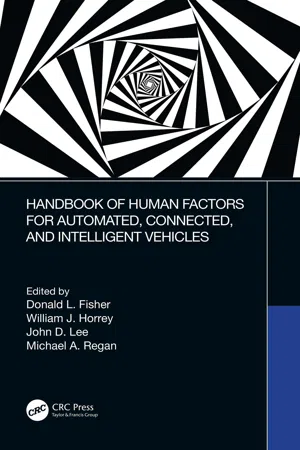
Handbook of Human Factors for Automated, Connected, and Intelligent Vehicles
- 552 pages
- English
- ePUB (mobile friendly)
- Available on iOS & Android
Handbook of Human Factors for Automated, Connected, and Intelligent Vehicles
About this book
Handbook of Human Factors for Automated, Connected, and Intelligent Vehicles
Subject Guide: Ergonomics & Human Factors
Automobile crashes are the seventh leading cause of death worldwide, resulting in over 1.25 million deaths yearly. Automated, connected, and intelligent vehicles have the potential to reduce crashes significantly, while also reducing congestion, carbon emissions, and increasing accessibility. However, the transition could take decades. This new handbook serves a diverse community of stakeholders, including human factors researchers, transportation engineers, regulatory agencies, automobile manufacturers, fleet operators, driving instructors, vulnerable road users, and special populations. It provides information about the human driver, other road users, and human–automation interaction in a single, integrated compendium in order to ensure that automated, connected, and intelligent vehicles reach their full potential.
Features
- Addresses four major transportation challenges—crashes, congestion, carbon emissions, and accessibility—from a human factors perspective
- Discusses the role of the human operator relevant to the design, regulation, and evaluation of automated, connected, and intelligent vehicles
- Offers a broad treatment of the critical issues and technological advances for the designing of transportation systems with the driver in mind
- Presents an understanding of the human factors issues that are central to the public acceptance of these automated, connected, and intelligent vehicles
- Leverages lessons from other domains in understanding human interactions with automation
- Sets the stage for future research by defining the space of unexplored questions
Frequently asked questions
- Essential is ideal for learners and professionals who enjoy exploring a wide range of subjects. Access the Essential Library with 800,000+ trusted titles and best-sellers across business, personal growth, and the humanities. Includes unlimited reading time and Standard Read Aloud voice.
- Complete: Perfect for advanced learners and researchers needing full, unrestricted access. Unlock 1.4M+ books across hundreds of subjects, including academic and specialized titles. The Complete Plan also includes advanced features like Premium Read Aloud and Research Assistant.
Please note we cannot support devices running on iOS 13 and Android 7 or earlier. Learn more about using the app.
Information
1 Introduction
Key Points
- Automated, connected, and intelligent vehicles hold great promise—increasing safety for all and mobility for underserved populations while decreasing congestion and carbon emissions.
- There may be unintended consequences of advances in automated technologies that affect the benefit that drivers can derive from these technologies, potentially slowing the development of the technologies themselves.
- Many of these unintended consequences center around human factors issues, issues between the driver and the vehicle, other road users, and the larger transportation system.
- Human factors research can be used to identify and seek to explain the unintended consequences, to develop and evaluate countermeasures, and to decrease, if not entirely avoid, any delay in the deployment of these technologies.
1.1 Background
Table of contents
- Cover
- Half Title
- Title Page
- Copyright Page
- Table of Contents
- Preface
- Editors
- Contributors
- Chapter 1 Introduction
- Chapter 2 Automated Driving: Decades of Research and Development Leading to Today’s Commercial Systems
- Chapter 3 Driver’s Mental Model of Vehicle Automation
- Chapter 4 Driver Trust in Automated, Connected, and Intelligent Vehicles
- Chapter 5 Public Opinion About Automated and Self-Driving Vehicles: An International Review
- Chapter 6 Workload, Distraction, and Automation
- Chapter 7 Situation Awareness in Driving
- Chapter 8 Allocation of Function to Humans and Automation and the Transfer of Control
- Chapter 9 Driver Fitness in the Resumption of Control
- Chapter 10 Driver Capabilities in the Resumption of Control
- Chapter 11 Driver State Monitoring for Decreased Fitness to Drive
- Chapter 12 Behavioral Adaptation
- Chapter 13 Distributed Situation Awareness and Vehicle Automation: Case Study Analysis and Design Implications
- Chapter 14 Human Factors Considerations in Preparing Policy and Regulation for Automated Vehicles
- Chapter 15 HMI Design for Automated, Connected, and Intelligent Vehicles
- Chapter 16 Human–Machine Interface Design for Fitness-Impaired Populations
- Chapter 17 Automated Vehicle Design for People with Disabilities
- Chapter 18 Importance of Training for Automated, Connected, and Intelligent Vehicle Systems
- Chapter 19 Connected Vehicles in a Connected World: A Sociotechnical Systems Perspective
- Chapter 20 Congestion and Carbon Emissions
- Chapter 21 Automation Lessons from Other Domains
- Chapter 22 HF Considerations When Testing and Evaluating ACIVs
- Chapter 23 Techniques for Making Sense of Behavior in Complex Datasets
- Chapter 24 Future Research Needs and Conclusions